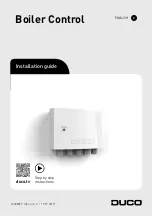
WHL-033 Rev. 1.29.16
40
Part 8 - Start-Up Preparation
A. Check / Control Water Chemistry
Chemical imbalance of your water can cause severe damage
to your boiler and associated equipment, and may also
affect efficiency. You may have to have your water quality
professionally analyzed to determine whether you need to
install a water softener. It is important that the water chemistry
on both the domestic hot water and central heating sides are
checked before installing the boiler, as water quality will affect
the reliability of the system. Outlined below are those water
quality parameters which need to be met in order for the
system to operate efficiently for many years. Failure of a heat
exchanger due to lime scale build-up on the heating surface,
low pH or other imbalance IS NOT covered by the warranty.
To assure extended service life, it is recommended to test water
quality prior to installation. Listed below are some guidelines.
Do not use petroleum-based cleaning or sealing compounds in
the boiler system. Damage to elastomer seals and gaskets in the
system could occur, resulting in substantial property damage.
Sodium less than 20 mGL
Water pH between 6.0 and 8.0
1. Maintain boiler water pH between 6.0 and 8.0. Check with
litmus paper or have it chemically analyzed by a water treatment
company.
2. If the pH differs from above, consult local water treatment
company for treatment needed.
Hardness less than 7 grains
Consult local water treatment companies for unusually hard
water areas (above 7 grains hardness).
Chlorine concentration less than 100 ppm
1. Using chlorinated fresh water should be acceptable since
drinking water chlorine levels are typically less than 5 ppm.
2. Do not connect the boiler to directly heat a swimming pool or
spa water.
3. Do not fill boiler or operate with water containing chlorine in
excess of 100 ppm.
Hardness:
Less than 7 grains
Chloride Levels:
Less than 100 ppm
pH Levels:
6-8
TDS:
Less than 2000 ppm
Sodium:
Less than 20 mGL
Clean system to remove sediment*
1. You must thoroughly flush the system (without boiler
connected) to remove sediment. The high-efficiency heat
exchanger can be damaged by buildup or corrosion due to
sediment.
2. For zoned systems, flush each zone separately through a
purge valve. (If purge valves and isolation valves are not already
installed, install them to properly clean the system.)
B. Check for Gas Leaks
Before starting the boiler, and during initial operation, smell
near the floor and around the boiler for gas odorant or any
unusual odor. Remove boiler front door and smell interior of
boiler enclosure. Do not proceed with startup if there is any
indication of a gas leak. Repair any leaks at once.
PROPANE BOILERS ONLY – The propane supplier mixes an
odorant with the propane to make its presence detectable.
In some instances the odorant can fade, and the gas may
no longer have an odor. Before startup (and periodically
thereafter), have the propane supplier verify the correct
odorant level in the gas.
Thoroughly clean and flush any system that has used glycol
before installing the boiler. Provide the customer with a material
safety data sheet (MSDS) on the fluid used.
3. Flush system until water runs clean and you are sure piping
is free of sediment.
*NOTE:
It is recommended you clean heat exchanger at
least once a year to prevent lime scale buildup. Follow the
maintenance procedure to clean the heat exchanger in the
Maintenance Section of this manual.
Test/replace freeze protection fluid
1. For systems using freeze protection fluids, follow fluid
manufacturer’s instructions to verify inhibitor level and that
other fluid characteristics are satisfactory.
2. Freeze protection fluid must be replaced periodically
due to degradation of inhibitors over time. Follow all fluid
manufacturer instructions.
NOTE: Boiler failure due to improper water chemistry is not
covered by warranty.
C. Freeze Protection (When Used)
1. Determine the freeze protection fluid quantity using total
system water content following the fluid manufacturer’s
instructions. Remember to include expansion tank water
content.
2. Local codes may require back flow preventer or actual
disconnect from city water supply.
3. When using freeze protection fluid with automatic fill, install
a water meter to monitor water makeup. Freeze protection
fluid may leak before the water begins to leak, causing
concentration to drop, reducing the freeze protection level.
NEVER use automotive or standard glycol antifreeze. Do
not use ethylene glycol made for hydronic systems. Use only
freeze-protection fluids certified by fluid manufacturer as
suitable for use with stainless steel boilers, verified in the fluid
manufacturer’s literature. Thoroughly clean and flush any
system that has used glycol before installing the new boiler.
Provide the boiler owner with a material safety data sheet
(MSDS) on the fluid used.
D. Fill and Test Water System
Ensure the boiler is full of water before firing the burner.
Failure to do so will damage the boiler. Such damage IS NOT
covered by warranty, and could result in property damage,
severe personal injury, or death.
Summary of Contents for WBMC**500
Page 36: ...WHL 033 Rev 1 29 16 36 Figure 27 Internal Connection Diagram ...
Page 59: ...WHL 033 Rev 1 29 16 59 Figure 32 500 Combustion System Replacement Parts Model ...
Page 60: ...WHL 033 Rev 1 29 16 60 Figure 33 850 Combustion System Replacement Parts Model ...
Page 61: ...WHL 033 Rev 1 29 16 61 Figure 34 Water Side Replacement Parts All Models ...
Page 62: ...WHL 033 Rev 1 29 16 62 Figure 35 Cabinet Replacement Parts All Models ...
















































